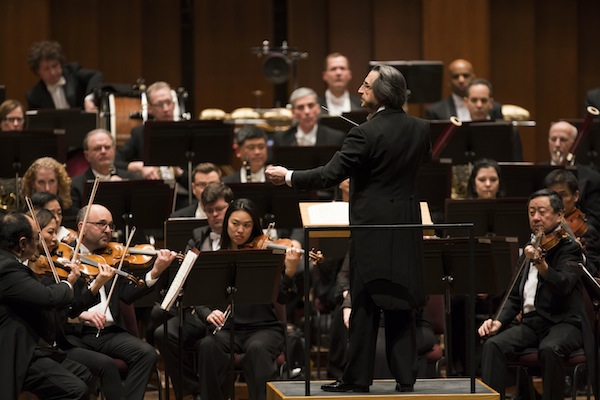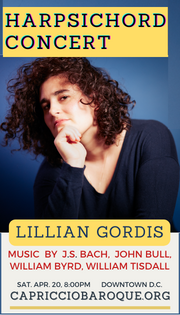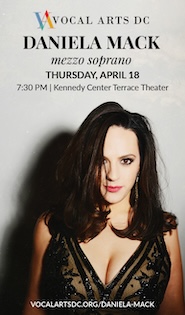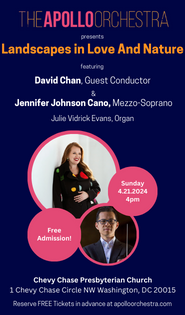Muti, Chicago Symphony warm up a chilly night at the Kennedy Center

Riccardo Muti conducted the Chicago Symphony Orchestra Wednesday night at the Kennedy Center. Photo: Todd Rosenberg
It took more than a decade, but the Chicago Symphony Orchestra returned to the Kennedy Center Concert Hall on Wednesday. Washington Performing Arts presented this beloved ensemble, which drew a large and vocal audience, on the first stop of its East Coast tour. The same organization presented the orchestra’s last visit in 2005, with Daniel Barenboim at the helm.
Regrettably, Washington heard the less exciting “B side” of the tour’s programs, and in spite of warm ovations that pulled conductor Riccardo Muti back to the stage several times, the orchestra did not offer an encore. It had been almost a decade since Muti’s last appearance in Washington, too, going back to his 2009 concert with the New York Philharmonic, just before he took over the leadership of the CSO.
Muti opened this unambitious program with one of his specialities, Verdi. He and the orchestra drew maximum drama from the Overture to I vespri siciliani, which on the page can be a rather plain piece. The opening section in dotted rhythms bristled with tension as military-style drums responded to each statement. Hushed woodwind solos, constrained in volume at Muti’s insistence, set up a striking contrast with the roiling storm of the fast section that followed.
After all that careful control, ardent melodies in violin and cello sections then soared. Muti’s attention to detail in Verdi included having the tuba player play the part Verdi wrote for cimbasso on that instrument, something that he has introduced to the orchestra during his tenure.
Rather than Jennifer Higdon’s Low Brass Concerto, given its world premiere by the CSO last week, this program featured a CSO commission by a far-less-experienced composer. The orchestra premiered many words of love, by Samuel Adams, last March. The piece opens with a raucous whir of sound that provided the last exciting moment of its twenty-some minutes. Little similarity to the song “Der Lindenbaum,” from Schubert’s Winterreise, which Adams says provided its inspiration, was apparent—likely because of the computer-enhanced techniques Adams used to transform the piece.
Extremely static overall in an almost continuous full-orchestra texture, much of the piece revolved around basic scales going up and then down. Adams obscured these scales with rustling heterophony, a busy whirring sort of sound, without highlighting many specific instruments. Against mostly long notes, percussion regularly provided rhythmic interest and some textural variety, especially nipple gong, crotales, and a cymbal scraped with a triangle beater around its circumference.
Adams is in the third year of his term as resident composer for the CSO, an extraordinary thing for someone with “little more than a dozen pieces in his catalog,” as the program note put it. (The notes also compared the “unfinished shed in North Berkeley that Adams found listed on Craigslist” where he composed the piece “during two months of solid work,” to Mahler’s Alpine composing hut—a metaphor too grand by half.) Adams, it should be added, is the son of celebrated composer John Adams.
Muti did a mini-festival of all four Brahms symphonies last May, from which he selected the Second Symphony, the sunniest of the quartet, for this tour. Brahms wanted moderate tempos in three of the four movements of this symphony, and all are set in major keys, the easygoing mood reflecting the work’s composition while the composer was on vacation among the mountain-side lakes of Carinthia.
Muti’s approach was ideal in the first movement, the gentle tempo reinforcing the evanescent soft sounds the musicians offered in the opening section, especially the distant calls of the horns. Only in the later, overly forceful contrapuntal section did the sound get distorted, starting with the edgy entrance of the oboe (Cynthia Koledo DeAlmeida, principal of the Pittsburgh Symphony, serving as guest principal on this tour and otherwise excellent). The low brass’s monumental sound gave an incisive edge to their hemiola motifs toward the end.
Muti approached the middle two movements in a way reminiscent of his dramatic Verdi, trying to wring too much drama from the score, a labored tempo and insistent intensity making the music overwrought. A slightly fast tempo likewise put the third movement on a somewhat spastic footing, even though Muti’s ever-graceful gestures, minimal but precise, were anything but agitated.
Happily Muti’s finale struck just the right spirited tempo, so that the fine skeins of woodwind runs, in exposed textures, were dizzying but precise. Again the low brass– including Brahms’s only part for tuba in his four symphonies–provided a magisterial close to this grand, exuberant movement.
The program will be repeated 7:30 p.m. Saturday at Carnegie Hall in New York. The CSO’s first Carnegie program (8 p.m. Friday) will include Stravinsky’s Scherzo fantastique, Higdon’s Low Brass Concerto, Chausson’s Poem of Love and the Sea with mezzo-soprano Clémentine Margaine, and Britten’s Four Sea Interludes from Peter Grimes. carnegiehall.org








Posted Feb 09, 2018 at 4:00 pm by LUANA MILLER
The CSO made a BIG mistake when it let Barenboim go. Muti is certainly no replacement for Daniel who left Muti with a fantastic organization. Too bad the CSO made change.